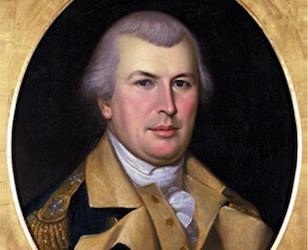
Nathaniel Greene (1742-86, age 43). Major-General Nathanael Greene was an American military officer and planter who served in the Continental Army during the American Revolutionary War.
Nathanael Greene’s rise to prominence as one of the most skilled and celebrated generals of the American Revolution appears unlikely based upon his early life. Greene was born to a devout Quaker family in Rhode Island in August of 1742. Greene had a deep interest in education, a characteristic frowned upon by the Society of Friends.
As relations between Great Britain and her North American colonies spiraled toward armed conflict, Greene helped establish a local militia unit, the Kentish Guards. A visible limp prevented Greene from joining the Guards. The Rhode Island Assembly, however, commissioned Greene a Brigadier General in the newly formed Army of Observation which marched to Boston following Lexington and Concord.
Greene’s early military career insured that the Continental Congress never regretted its decision to promote him. After the Siege of Boston in 1776, Greene proved to be an able commander when he took command of the city upon the British retreat.
However, the young general’s career was not without blemish: during the New York Campaign, he lost Forts Washington and Lee. Although racked by guilt for these loses, Greene subsequently led a column of troops to victory at the Battle of Trenton and the Battle of Princeton.
Following the Battle of Brandywine and the Battle of Germantown in the Pennsylvania campaign in 1777, the Continental Congress appointed him Quartermaster General under the condition that he retain the right to command troops in the field. He performed his duties as Quartermaster brilliantly, skillfully supplying Continental troops while dealing with logistical and bureaucratic challenges.
Greene’s most notable appointment came in October 1780 when the Continental Congress granted Washington with the power to appoint a new southern commander. Washington selected Greene. Up to that point, Congress struggled to select the right commanders in the South: Robert Howe lost Savannah, Benjamin Lincoln lost Charleston, and Horatio Gates was defeated at Camden, South Carolina.
Greene’s martial skills shone brightest as commander of the southern theater. Soon after he took command, the tide of war began to turn in favor of the Patriots. Greene decided to divide his troops in the hopes that the British would be forced to follow suit. The tactic worked as Greene’s subordinate, Brig. Gen. Daniel Morgan won a victory at Cowpens early in 1781.
After the British victory over at Greene at the Battle of Guilford Courthouse, the much depleted British force under Charles Cornwallis withdrew to Wilmington while Greene and his men turned south to reconquer the South Carolina backcountry. Throughout 1781, Greene steadily drove the British back to an isolated position at Charleston, which they abandoned the following December.
George Washington trusted Greene immensely, and that trust only grew over the course of the war. Greene’s legacy endures. He is one of the most celebrated generals of the Revolution for his crucial role in wresting the southern theater from the British and securing a revolutionary Patriot victory.